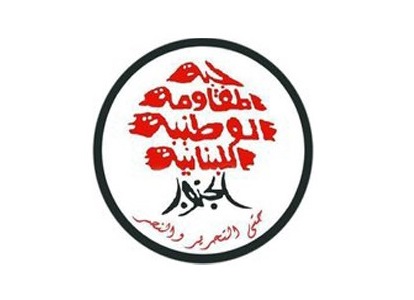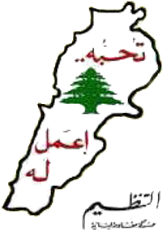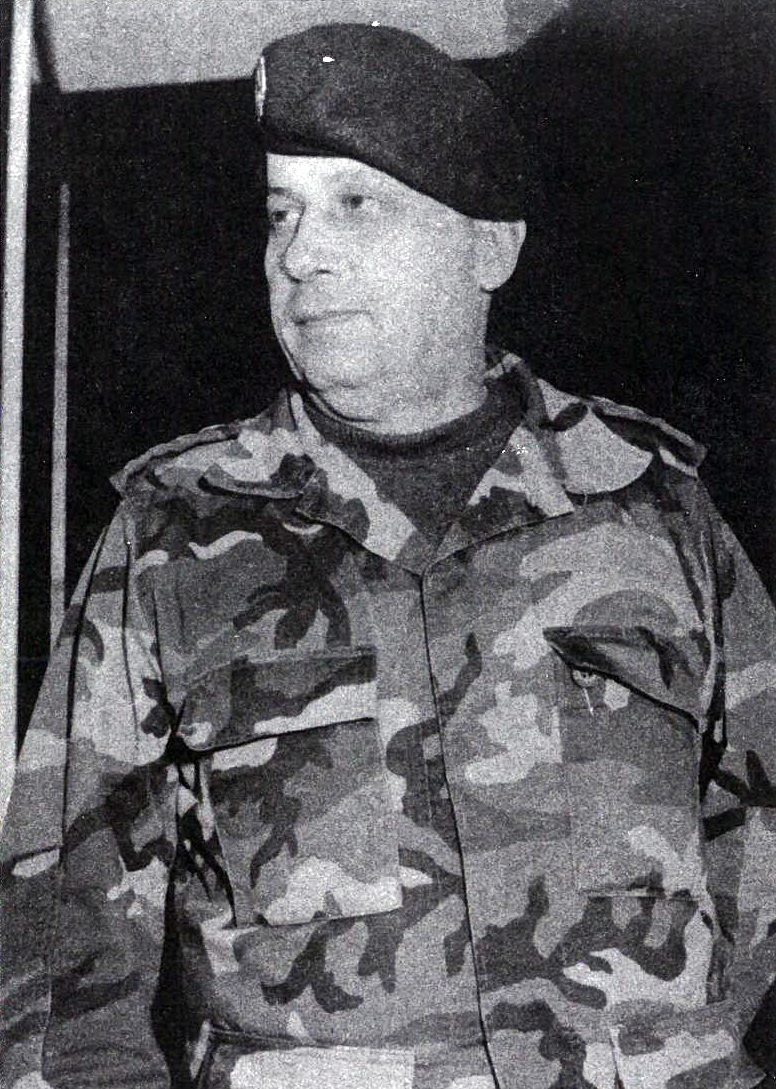|
Lebanese Forces – Executive Command
The Lebanese Forces – Executive Command or LFEC (Arabic: القوات اللبنانية - القيادة التنفيذية , ''Al-Quwwat al-Lubnaniyya – Al-Qiyada Al-Tanfeethiyya''), was a splinter group from the Lebanese Forces led by Elie Hobeika, based at the town of Zahlé in the Beqaa valley during the late 1980s. It was initially founded in January 1986 under the title Lebanese Forces – Uprising or LFU (Arabic: القوات اللبنانية - الانتفاضة , ''Al-Quwwat al-Lubnaniyya – Intifada''), but later changed its designation. Origins The LFU was formed by Hobeika at Zahlé out of his LF supporters, who sought refuge in the Syrian-controlled Beqaa after being ousted from east Beirut in January 1986 by the Lebanese Forces' faction led by Samir Geagea. Renamed Lebanese Forces – Executive Command later that year and financed by Syria, Hobeika and its men conveyed little or no support at all from the Greek-Catholic citizens of Zahlé, who preferr ... [...More Info...] [...Related Items...] OR: [Wikipedia] [Google] [Baidu] |
Lebanese Civil War
The Lebanese Civil War ( ar, الحرب الأهلية اللبنانية, translit=Al-Ḥarb al-Ahliyyah al-Libnāniyyah) was a multifaceted armed conflict that took place from 1975 to 1990. It resulted in an estimated 120,000 fatalities and an exodus of almost one million people from Lebanon. The diversity of the Lebanese people, Lebanese population played a notable role in the lead-up to and during the conflict: Lebanese Sunni Muslims, Sunni Muslims and Christianity in Lebanon, Christians comprised the majority in the coastal cities; Shia Islam, Shia Muslims were primarily based in Southern Lebanon, the south and the Beqaa Valley in the east; and Lebanese Druze, Druze and Christians populated the country's mountainous areas. The Lebanese government had been run under the significant influence of elites within the Lebanese Maronite Christians, Maronite Christian community. The link between politics and religion had been reinforced under the Mandate for Syria and Lebanon, F ... [...More Info...] [...Related Items...] OR: [Wikipedia] [Google] [Baidu] |
Hezbollah
Hezbollah (; ar, حزب الله ', , also transliterated Hizbullah or Hizballah, among others) is a Lebanese Shia Islamist political party and militant group, led by its Secretary-General Hassan Nasrallah since 1992. Hezbollah's paramilitary wing is the Jihad Council, and its political wing is the Loyalty to the Resistance Bloc party in the Lebanese Parliament. After the Israeli invasion of Lebanon in 1982, the idea of Hezbollah arose among Lebanese clerics who had studied in Najaf, and who adopted the model set out by Ayatollah Khomeini after the Iranian Revolution in 1979. After failing to agree on a name for the new organisation, the party's founders adopted the name chosen by Ayatollah Khomeini, Hezbollah. The organization was established as part of an Iranian effort, through funding and the dispatch of a core group of Islamic Revolutionary Guard Corps (pasdaran) instructors, to aggregate a variety of Lebanese Shia groups into a unified organization to resist the I ... [...More Info...] [...Related Items...] OR: [Wikipedia] [Google] [Baidu] |
Recoilless Rifles
A recoilless rifle, recoilless launcher or recoilless gun, sometimes abbreviated "RR" or "RCL" (for ReCoilLess) is a type of lightweight artillery system or man-portable launcher that is designed to eject some form of countermass such as propellant gas from the rear of the weapon at the moment of firing, creating forward thrust that counteracts most of the weapon's recoil. This allows for the elimination of much of the heavy and bulky recoil-counteracting equipment of a conventional cannon as well as a thinner-walled barrel, and thus the launch of a relatively large projectile from a platform that would not be capable of handling the weight or recoil of a conventional gun of the same size. Technically, only devices that use spin-stabilized projectiles fired from a rifled barrel are recoilless rifles, while smoothbore variants (which can be fin-stabilized or unstabilized) are recoilless guns. This distinction is often lost, and both are often called recoilless rifles. Though sim ... [...More Info...] [...Related Items...] OR: [Wikipedia] [Google] [Baidu] |
Heavy Machine-guns
A heavy machine gun (HMG) is significantly larger than light, medium or general-purpose machine guns. HMGs are typically too heavy to be man-portable (carried by one person) and require mounting onto a weapons platform to be operably stable or tactically mobile, have more formidable firepower, and generally require a team of personnel for operation and maintenance. There are two generally recognized classes of weapons identified as HMGs. The first are weapons from World War I identified as "heavy" due to the weight and cumbersomeness of the weapons themselves, which prevents infantrymen from transporting on foot, such as the M1917 Browning machine gun. The second are large-caliber (12.7×99mm, 12.7×108mm, 14.5×114mm, or larger) machine guns, pioneered by John Browning with the M2 machine gun, designed to provide increased effective range, penetration and destructive power against covers, vehicles, aircraft and light buildings/fortifications beyond the standard-caliber rif ... [...More Info...] [...Related Items...] OR: [Wikipedia] [Google] [Baidu] |
Technical (vehicle)
A technical, in professional military parlance often called a non-standard tactical vehicle (NSTV), is a light improvised fighting vehicle, typically an open-backed civilian pickup truck or four-wheel drive vehicle, mounting a machine gun, anti-aircraft autocannon, rotary cannon, anti-tank weapon, anti-tank gun, ATGM, Mortar (weapon), mortar, multiple rocket launcher, recoilless rifle or other support weapon (somewhat like a light military gun truck or potentially even a self-propelled gun). The neologism ''technical'' describing such a vehicle is believed to have originated in Somalia during the Somali Civil War in the early 1990s. Barred from bringing in private security, non-governmental organizations hired local gunmen to protect their personnel, using money defined as "technical assistance grants". Eventually the term broadened to include any vehicle carrying armed men. However, an alternative account is given by Michael Maren, who says the term was first used in Somalia in ... [...More Info...] [...Related Items...] OR: [Wikipedia] [Google] [Baidu] |
West Beirut
Beirut, french: Beyrouth is the capital and largest city of Lebanon. , Greater Beirut has a population of 2.5 million, which makes it the third-largest city in the Levant region. The city is situated on a peninsula at the midpoint of Lebanon's Mediterranean coast. Beirut has been inhabited for more than 5,000 years, and was one of Phoenicia's most prominent city states, making it one of the oldest cities in the world (see Berytus). The first historical mention of Beirut is found in the Amarna letters from the New Kingdom of Egypt, which date to the 14th century BC. Beirut is Lebanon's seat of government and plays a central role in the Lebanese economy, with many banks and corporations based in the city. Beirut is an important seaport for the country and region, and rated a Beta + World City by the Globalization and World Cities Research Network. Beirut was severely damaged by the Lebanese Civil War, the 2006 Lebanon War, and the 2020 massive explosion in the Por ... [...More Info...] [...Related Items...] OR: [Wikipedia] [Google] [Baidu] |
Maronite Christianity In Lebanon
Lebanese Maronite Christians ( ar, المسيحية المارونية في لبنان; syc, ܡܫܝܚܝ̈ܐ ܡܪ̈ܘܢܝܐ ܕܠܒܢܢ) are adherents of the Maronite Church in Lebanon, which is the largest Christianity in Lebanon, Christian denomination in the country. The Maronite Church is an Eastern Catholic Churches, Eastern Catholic Church in full communion with the worldwide Catholic Church. The Lebanese Maronite Christians are believed to constitute about 30% of the total population of Lebanon according to election results. Lebanon's constitution was intended to guarantee political representation for each of the nation's ethno-religious groups. The Maronites, Maronite Catholics and the Druze founded modern Lebanon in the early eighteenth century, through the ruling and social system known as the "Maronite-Druze dualism" in Mount Lebanon Mutasarrifate. Under the terms of an unwritten agreement known as the National Pact between the various political and religious leaders ... [...More Info...] [...Related Items...] OR: [Wikipedia] [Google] [Baidu] |
Michel Aoun
Michel Naim Aoun ( ar, ميشال نعيم عون ; born 30 September 1933) is a Lebanese politician and former military general who served as the President of Lebanon from 31 October 2016 until 30 October 2022. Born in Haret Hreik to a Maronite Christian family, Aoun joined the Military Academy in 1955 and graduated as an artillery officer in the Lebanese Army. In 1984, he became the youngest Commander of the Army, at the age of 49 years. On 22 September 1988 during the fourth phase of the Lebanese Civil War, the departing President Amine Gemayel appointed him as the interim Prime Minister of a Military Government, after the parliament failed to elect a new president, and dismissed the current government headed by the Acting Prime Minister Selim Hoss. This controversial decision saw the rise of two rival governments contending for power at that time, with Aoun being supported mainly by Christians and Iraq, while the other being supported by Muslims and Syria. He decl ... [...More Info...] [...Related Items...] OR: [Wikipedia] [Google] [Baidu] |
Melkite Christianity In Lebanon
Lebanese Melkite Christians are the adherents of the Melkite Greek Catholic Church in Lebanon, which is the third largest Christian group in the country after the Maronite Church and the Greek Orthodox Church of Antioch. The Lebanese Melkite Christians are believed to constitute about 5% of the total population of Lebanon. Note that the following percentages are estimates only. However, in a country that had last census in 1932, it is difficult to have correct population estimates. Under the terms of an unwritten agreement known as the National Pact between the various political and religious leaders of Lebanon, the Melkite community in Lebanon has eight reserved seats in the Parliament of Lebanon. Lebanese Melkite-born Notables *André Haddad *Najwa Karam *Marwan Fares *Majida El Roumi *John Elya *Peter IV Geraigiry *Saad Haddad *Marie Keyrouz *Wael Kfoury *Amin Maalouf *Henri Philippe Pharaoun *Michel Pharaon *Joseph Raya *Omar Sharif *Charbel Nahas *Jean Makaron *Nicolas ... [...More Info...] [...Related Items...] OR: [Wikipedia] [Google] [Baidu] |
Syria
Syria ( ar, سُورِيَا or سُورِيَة, translit=Sūriyā), officially the Syrian Arab Republic ( ar, الجمهورية العربية السورية, al-Jumhūrīyah al-ʻArabīyah as-Sūrīyah), is a Western Asian country located in the Eastern Mediterranean and the Levant. It is a unitary republic that consists of 14 governorates (subdivisions), and is bordered by the Mediterranean Sea to the west, Turkey to the north, Iraq to the east and southeast, Jordan to the south, and Israel and Lebanon to the southwest. Cyprus lies to the west across the Mediterranean Sea. A country of fertile plains, high mountains, and deserts, Syria is home to diverse ethnic and religious groups, including the majority Syrian Arabs, Kurds, Turkmens, Assyrians, Armenians, Circassians, Albanians, and Greeks. Religious groups include Muslims, Christians, Alawites, Druze, and Yazidis. The capital and largest city of Syria is Damascus. Arabs are the largest ethnic group, ... [...More Info...] [...Related Items...] OR: [Wikipedia] [Google] [Baidu] |
Samir Geagea
Samir Farid Geagea ( ar, سمير فريد جعجع Lebanese pron.: , also spelled Samir Ja'ja'; born 25 October 1952) is a Lebanese politician and militia commander who has been leading the Lebanese Forces party and dissolved militia since 1986. Born in Ain al-Remaneh in Beirut with origins from Bsharri, Geagea joined the Kataeb Party in his early years. He led the Northern Front in the Lebanese Forces from 1979 to 1984. In March 1985, after the deterioration of the Christian political situation in the eastern regions after the assassination of the Lebanese Forces leader Bachir Gemayel, he led, jointly with Elie Hobeika and Karim Pakradouni, an uprising that led to control of the political situation without any bloodshed. On January 15, 1986, Geagea led a movement against the tripartite agreement sponsored by Syria to become the commander of the Lebanese Forces after the overthrow of Elie Hobeika, the head of the executive body at the time and one of the signatories o ... [...More Info...] [...Related Items...] OR: [Wikipedia] [Google] [Baidu] |
January 1986 Lebanese Forces Coup
On January 15, 1986, forces loyal to Lebanese president Amine Gemayel and Samir Geagea, intelligence chief of the Lebanese Forces (LF), ousted Elie Hobeika from his position as leader of the LF and replaced him with Geagea. The coup came in response to Hobeika's signing of the Syrian-sponsored Tripartite Accord that aimed to put an end to the Lebanese Civil War. Background The tussle between Samir Geagea and Elie Hobeika for control over the Lebanese Forces (LF) had started as early as March 1985. That same month, Samir Geagea gained control over the LF after defeating the last leader of the Phalangist militia, Fouad Abou Nader. In May of that same year, however, Elie Hobeika was appointed to lead that unit. In December 1985, Hobeika signed in the name of the LF an agreement with the Syrian government, the Druze Progressive Socialist Party (PSP) led by Walid Jumblatt, and the Shia Muslim Amal Movement headed by Nabih Berri, which became known as the Tripartite Accord. One o ... [...More Info...] [...Related Items...] OR: [Wikipedia] [Google] [Baidu] |







